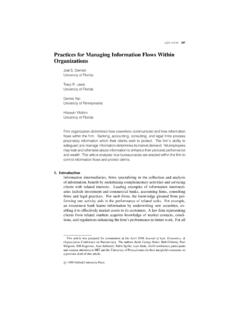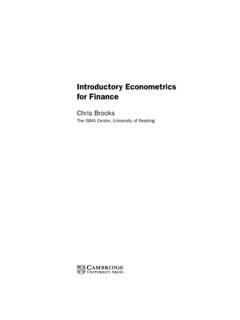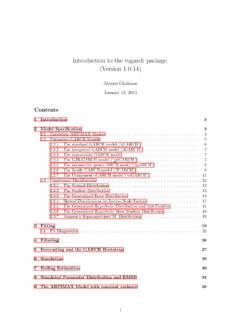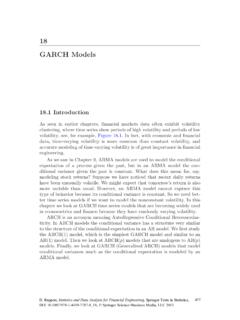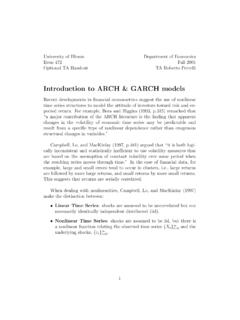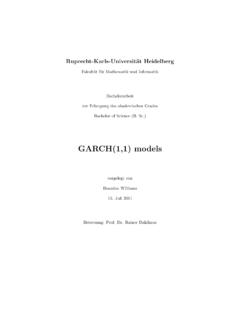Transcription of GENERALIZED AUTOREGRESSIVE CONDITIONAL …
1 Journal of Econometrics 31 (1986) 307-327. North-Holland GENERALIZED AUTOREGRESSIVE CONDITIONAL HETEROSKEDASTICITY Tim BOLLERSLEV* University of California at San Diego, La Jolla, CA 92093, USA Institute of Economics, University of Aarhus, Denmark Received May 1985, final version received February 1986 A natural generalization of the ARCH ( AUTOREGRESSIVE CONDITIONAL Heteroskedastic) process introduced in Engle (1982) to allow for past CONDITIONAL variances in the current CONDITIONAL variance equation is proposed. Stationarity conditions and autocorrelation structure for this new class of parametric models are derived. Maximum likelihood estimation and testing are also considered.
2 Finally an empirical example relating to the uncertainty of the inflation rate is presented. 1. Introduction While conventional time series and econometric models operate under an assumption of constant variance, the ARCH ( AUTOREGRESSIVE CONDITIONAL Heteroskedastic) process introduced in Engle (1982) allows the CONDITIONAL variance to change over time as a function bf past errors leaving the uncondi- tional variance constant. This type of model behavior has already proven useful in modelling several different economic phenomena. In Engle (1982), Engle (1983) and Engle and Kraft (1983), models for the inflation rate are constructed recognizing that the uncertainty of inflation tends to change over time.
3 In Coulson and Robins (1985) the estimated inflation volatility is related to some key macroeconomic variables. Models for the term structure using an estimate of the CONDITIONAL variance as a proxy for the risk premium are given in Engle, Lilien and Robins (1985). The same idea is applied to the foreign exchange market in Domowitz and Hakkio (1985). In Weiss (1984) ARMA models with ARCH errors are found to be successful in modelling thirteen different macroeconomic time series. Common to most of the above applications however, is the introduction of a rather arbitrary linear declining lag structure in the condi- * I am grateful to David Hendry and Rob Engle for introducing me to this new idea, and to Rob Engle for many helpful discussions.
4 I would also like to thank Sastry Pantula for suggesting the alternative parameterization, two anonymous referees for useful comments, and Kirsten Stentoft for typing the manuscript. The usual disclaimer applies. 0304-4076/86/$ 1986, Elsevier Science Publishers (North-Holland) 308 T. Bollerslev, Generalization of A R C H process tional variance equation to take account of the long memory typically found in empirical work, since estimating a totally free lag distribution often will lead to violation of the non-negativity constraints. In this paper a new, more general class of processes, garch ( GENERALIZED AUTOREGRESSIVE CONDITIONAL Heteroskedastic), is introduced, allowing for a much more flexible lag structure.
5 The extension of the ARCH process to the garch process bears much resemblance to the extension of the standard time series AR process to the general ARMA process and, as is argued below, permits a more parsimonious description in many situations. The paper proceeds as follows. In section 2 the new class of processes is formally presented and conditions for their wide-sense stationarity are derived. The simple garch (1,1) process is considered in some detail in section 3. It is well established, that the autocorrelation and partial autocorrelation func- tions are useful tools in identifying and checking time series behavior of the ARMA form in the CONDITIONAL mean.
6 Similarly the autocorrelations and partial autocorrelations for the squared process may prove helpful in identify- ing and checking garch behavior in the CONDITIONAL variance equation. This is the theme in section 4. In section 5 maximum likelihood estimation of the linear regression model with garch errors is briefly discussed, and it is seen that the asymptotic independence between the estimates of the mean and the variance parameters carries over from the ARCH regression model. Some test results are presented in section 6. As in the ARMA analogue, cf. Godfrey (1978), a general test for the presence of garch is not feasible. Section 7 contains an empirical example explaining the uncertainty of the inflation rate.
7 It is argued that a simple garch model provides a marginally better fit and a more plausible learning mechanism than the ARCH model with an eighth- order linear declining lag structure as in Engle and Kraft (1983). 2. The garch (p,q) process The ARCH process introduced by Engle (1982) explicitly recognizes the difference between the unconditional and the CONDITIONAL variance allowing the latter to change over time as a function of past errors. The statistical properties of this new parametric class of models has been studied further in Weiss (1982) and in a recent paper by Milhoj (1984). In empirical applications of the ARCH model a relatively long lag in the CONDITIONAL variance equation is often called for, and to avoid problems with negative variance parameter estimates a fixed lag structure is typically im- posed, cf.
8 Engle (1982), Engle (1983) and Engle and Kraft (1983). In this light it seems of immediate practical interest to extend the ARCH class of models to allow for both a longer memory and a more flexible lag structure. Let e t denote a real-valued discrete-time stochastic process, and ~b, the information set (a-field) of all information through time t. The garch ( p, q) 7~ Bollerslev, Generalization of A RCH process 309 process ( GENERALIZED AUTOREGRESSIVE CONDITIONAL Heteroskedasticity) is then given by 1 ~'tl~t-1 -- N(0, ht) , (1) q P ht = or0 + E 2 OtiEt-i "}- E t~iht-i i=1 i~l where = Ot 0 +A(t)e2t -t- O(t)ht, p>0, q>0 a o>0, a i>_0, i=1 .. ,q, fl,>0, i=1 .. p.
9 (2) For p = 0 the process reduces to the ARCH(q) process, and for p = q = 0 E t is simply white noise. In the ARCH(q) process the CONDITIONAL variance is specified as a linear function of past sample variances only, whereas the garch (p, q) process allows lagged CONDITIONAL variances to enter as well. This corresponds to some sort of adaptive learning mechanism. The garch (p,q) regression model is obtained by letting the et'S be innovations in a linear regression, =y, - x;b, (3) where Yt is the dependent variable, x, a vector of explanatory variables, and b a vector of unknown parameters. This model is studied in some detail in section 5. If all the roots of 1-B(z)=0 lie outside the unit circle, (2) can be rewritten as a distributed lag of past e~ 's, ht = Oto(1 - B(1))-I + A(L)(1 - B(L))-te~ ( = a o 1 - Bi + ~iE2-i, i~1 i=l (4) which together with (1) may be seen as an infinite-dimensional ARCH(oo) process.)
10 The 8i's are found from the power series expansion of D(L)= aWe follow Engle (1982) in assuming the CONDITIONAL distribution to be normal, but of course other distributions could be applied as well. Instead of E 2_I in eq. (2) the absolute value of et- may be more appropriate in some appfications; cf. McCulloch (1983). 310 T. Bollerslev, Generalization of A R C H process A(L)(1 - B(L)) -1, j=l = Bs'S,-j, j=l i=1 .. q, i=q+l .. (5) where n = min( p, i - 1}. It follows, that if B(1) < 1, 6i will be decreasing for i greater than m = max{ p, q }. Thus if D(1) < 1, the garch (p, q) process can be approximated to any degree of accuracy by a stationary ARCH(Q) for a sufficiently large value of Q.)
